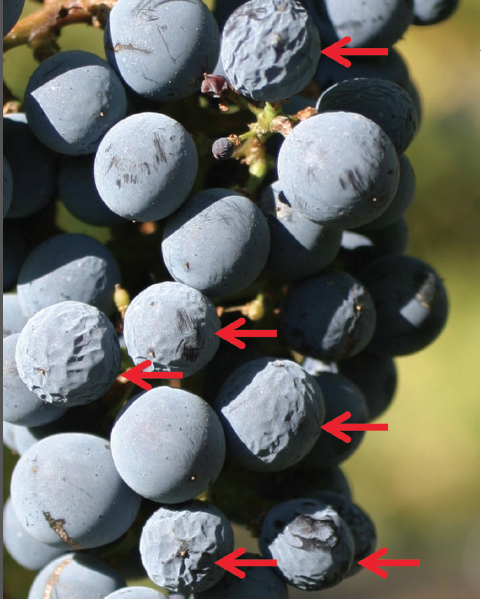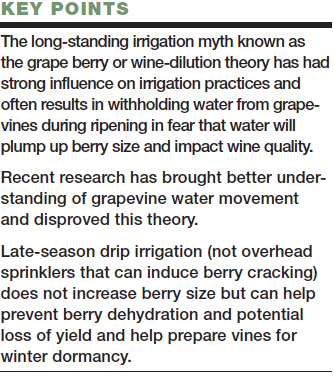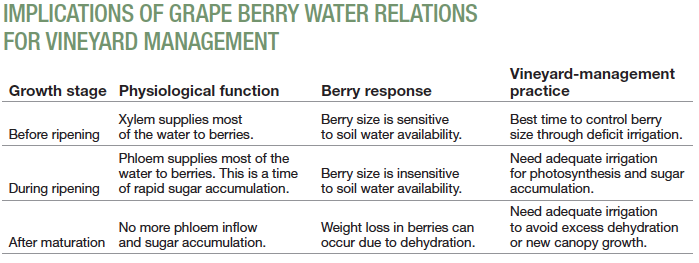
|
|
PRINT » |
|
|
E-MAIL THIS PAGE » |
|
|
CLOSE THIS WINDOW » |
Grapes and Irrigation Myths Debunked
Research shows post-véraison irrigation does not increase berry size but may reduce dehydration

Essential in arid and semiarid grapegrowing regions, irrigation is a management tool used to manipulate yield and enhance the quality of wine grapes.4 However, longstanding myths of the wine industry still have strong influence on irrigation practices—to the detriment of vine health and the wine grape grower’s pocketbook.
The irrigation myth, known as the grape berry or wine-dilution theory, is the belief that late-season irrigation increases berry size and dilutes berry sugars and other quality-related components of the grapes. It is an Old-World irrigation dogma that often results in withholding irrigation from grapevines during fruit ripening for fear water will plump up berry size, and wine quality will suffer. This theory is not supported by science.
A better understanding of water relations of grape berries is fundamental to applying research-based irrigation practices. The Washington State Wine Commission, a state agency that represents all wine grape growers and wineries, has helped support research at Washington State University to develop optimum irrigation management for white grape varieties and regulated deficit-irrigation strategies for red cultivars. Research funded by the Northwest Center for Small Fruits Research has focused on grape berry water relations and the role of water in berry development. Both basic and applied research have brought better understanding of berry water movement and have practical implications for vineyard irrigation management by laying the foundation for development of more effective irrigation strategies for the wine industry.
Water ins and outs
The grape berry has two circulatory systems: the xylem and phloem. The xylem is the main pipeline that delivers water and mineral nutrients to the berry. Water can move in and out of the berry through the xylem, depending on the direction of pressure gradient.
Pressure gradient in the xylem can be thought of as water coming out of a garden hose. When the faucet is turned on, water moves through the hose from the point of higher pressure to the point of lower pressure. The gradient is the difference in pressure between these two points, and the direction of flow is the same as the direction of the gradient.
The phloem imports mostly water and sugar into the berry, but unlike the xylem, the phloem can transport only one direction: into the berry. Think of the vascular pathway as a conveyor belt that brings the sugary solution made from photosynthesis by the leaf (the source), into the berry (the sink). As the berry fills up with the sugary solution, a surplus of water can build up in the ripening fruit. The berry disposes of excess water by berry transpiration, which is evaporation across the berry skin into the atmosphere, and recycling it back into the vine through the xylem.
Past research showed that the xylem lost function after véraison, and its role of being the berry’s main water supplier declined.2 Scientists thought the berry’s rapid expansion caused the xylem to collapse, and therefore the berry was hydraulically isolated from the mother vine.
By tracing water movement in the xylem with a xylem-mobile dye, it was found that ripening berries remain hydraulically connected to the mother vine.1 The dye was put in the berry from the stylar end (the end opposite the pedicel), and then it was traced in the pedicels, peduncles and even shoots of the vine. This showed that the water can flow out of ripening berries through the xylem, and therefore the xylem can still conduct water.
 In addition, the conductivity that determines how easily water can flow through the xylem remained high at the onset of ripening.5 Therefore, it was still a mystery as to why water stopped entering ripening berries through the xylem. In order to understand this, dye movement was observed when pressure in the xylem was manipulated. When detached clusters with ripening and ripe berries were pressurized from the peduncle end, the inward dye movement was restored (which normally ceased around the pedicel end without pressurization).3
In addition, the conductivity that determines how easily water can flow through the xylem remained high at the onset of ripening.5 Therefore, it was still a mystery as to why water stopped entering ripening berries through the xylem. In order to understand this, dye movement was observed when pressure in the xylem was manipulated. When detached clusters with ripening and ripe berries were pressurized from the peduncle end, the inward dye movement was restored (which normally ceased around the pedicel end without pressurization).3
On the other hand, when the roots of pot-grown vines were pressurized, the outward dye movement from berries was stopped.4 The results indicated that the changes in xylem pressure were the culprit for the decline in xylem inflow.
What led to changes in xylem pressure?
The other water-conducting structure, the phloem, runs side by side with the xylem. The phloem inflow to the berry is regulated by rates of berry growth, transpiration, respiration and sugar accumulation as well as sugar concentration of the pedicel phloem sap. During véraison, phloem inflow increases due to the rapid sugar accumulation.
Using a grape berry growth model, it was estimated that, to meet the demand of berry sugar accumulation, the volume of phloem-inflow must exceed the water demand for berry growth and transpiration.4 After the sugar-water solution moves to the berry, the sugars are unbundled from the solution, and excess water is left behind. This surplus water may alter the pressure gradient inside the xylem and, thus, alter the direction of xylem-flow during berry ripening.
Different sensitivity to soil-water availability
Studies of grape berry water relations have revealed that grape berries have different sensitivity to soil-water availability, depending on their developmental stages.1,3,4 Before véraison, berries are sensitive to water stress and rewatering: Berries shrink in response to water stress imposed and recover rapidly by expanding after rewatering. But during véraison, very few changes in berry size were observed in response to water stress or rewatering.
 Soil-water availability affects xylem water supply to the berries directly. The reason that ripening berries become insensitive to soil moisture changes is because the surplus phloem water buffers the ripening berries from changes i
n the xylem water supply. To further prove this, the roots of well-watered, pot-grown vines were pressurized at 1 MPa (145 psi) for three hours. During pressurization, water was pushed upward through the xylem (as if the soil water supply was increased by root pressurization). From the start of pressurization, the size of pre-véraison berries increased. But the size of post-véraison berries remained the same. Clearly, post-véraison berries did not expand with increased soil water supply.
Soil-water availability affects xylem water supply to the berries directly. The reason that ripening berries become insensitive to soil moisture changes is because the surplus phloem water buffers the ripening berries from changes i
n the xylem water supply. To further prove this, the roots of well-watered, pot-grown vines were pressurized at 1 MPa (145 psi) for three hours. During pressurization, water was pushed upward through the xylem (as if the soil water supply was increased by root pressurization). From the start of pressurization, the size of pre-véraison berries increased. But the size of post-véraison berries remained the same. Clearly, post-véraison berries did not expand with increased soil water supply.
But, berries do still grow during ripening, so where do they get water to support their growth? The answer is the phloem. At the start of ripening, the phloem brings both water and sugar into the berries. Since the sugar concentration (commonly measured as Brix) of berries increases during ripening, the phloem deposits more sugar than water inside the berries.
Late-season irrigation benefits
Consequently, it was found that the most effective time to control or influence berry size is before véraison. Since berries are sensitive to soil moisture availability before véraison, smaller berry size can be achieved by imposing water stress. While berry growth still occurs during and post-véraison, increase in berry size is supported by phloem inflow and thus is accompanied with sugar import. Therefore, it is a myth that late-season drip irrigation just adds water to the berry and plumps it up.
Irrigation close to harvest helps maintain a healthy canopy for leaf photosynthesis, sugar transport through the phloem and sugar accumulation in the berries to continue ripening. A healthy canopy helps replenish storage reserves in the vine’s permanent structures before dormancy. In addition, post-véraison irrigation can reduce or stop any previous decrease in berry size from dehydration.
But there is a difference between drip and overhead sprinkler irrigation. For clarification, drip irrigation after véraison will not decrease berry sugar concentration or dilute berry quality. The reason behind this is that drip irrigation supplies water to the soil; as mentioned, berries become insensitive to soil moisture after véraison. Post-véraison berry enlargement is contributed by phloem inflow, which brings both sugar and water.
Berry dehydration
Generally, it has been found that berries reach maximum sugar content around 24º Brix. It is likely that different cultivars have different maximum sugar levels, and this needs further research. Once berries reach their maximum sugar content, any further increase in Brix is the result of the berry dehydrating and shrinking, not from an increase in sugar content.
Unpublished research results have shown that after ripeness, berries generally lose 5% in weight for each degree increase in Brix. Although late-season weight loss varies by cultivar, when dehydration is visible and berries show wrinkling and shrinkage, the crop has already lost about 10% in weight.6
Goldilocks principle
Withholding drip irrigation after véraison can cause too much water stress before harvest and reduce yield and potential profits for the grower. Late-season irrigation can be thought of in terms of the “Goldilocks” principle:
Not too little: Avoid too much stress and berry dehydration before harvest.
Not too much: Avoid new canopy growth.
But just right: Alleviate berry dehydration if there is extended hang time and replenish vine’s storage reserves before dormancy.
The bottom line
Based on these research results, growers and winemakers should have no worries or fears that drip irrigation applied during véraison and through harvest will dilute fruit flavors or negatively impact wine grape quality. This does not apply to overhead sprinkler irrigation, which can mimic ill-timed rain near harvest. Late-season drip irrigation can help prevent berry dehydration and potential loss of yield, and keep vines healthy and prepared for winter.
Dr. Yun Zhang is a post-doctorate fellow and adjunct faculty in the Viticulture and Enology Program of Washington State University. Dr. Zhang’s research interests include grape berry ripening, water relations and irrigation management. She is conducting a research project studying the impacts of heat stress and drought stress on grapevine growth and development.
Melissa Hansen, research program manager for the Washington State Wine Commission, works to make viticulture and enology research supported by the Washington wine industry more accessible to the state’s growers and winemakers. Hansen spent nearly 20 years as a journalist for Good Fruit Grower magazine and was involved with California’s table grape and tree fruit industries for 15 years.
Additional funding for this project came from the U.S. Department of Agriculture’s Northwest Center for Small Fruits Research, Rhone Rangers, the WSU Horticulture Department and Chateau Ste. Michelle Distinguished Professorship.
References
1. Keller, M., J.P. Smith and B.R. Bondada. 2006 “Ripening grape berries remain hydraulically connected to the shoot.” J. of Experimental Botany 57: 2577- 2587.
2. Duing, H., A. Lang and F. Oggionni. 1987 “Patterns of water flow in Riesling berries in relation to developmental changes in their xylem morphology.” Vitis 26: 123-131 40: 1069-1078.
3. Keller, M., Y. Zhang, P.M. Shrestha, M. Biondi and B.R. Bondada. 2015 “Sugar demand of ripening grape berries leads to recycling of surplus phloem water via the xylem.” Plant Cell & Environment 38: 1048-1059.
4. Zhang, Y. and M. Keller. 2017 “Discharge of surplus phloem water may be required for normal grape ripening.” J. of Experimental Botany 68: 585-595.
5. Choat, B, et al. 2009 “Vascular function in grape berries across development and its relevance to apparent hydraulic isolation.” Plant Physiology 151: 1677-1697.
6. Zhang, Y. 2017 “Grapes and Irrigation: Of Myths and Dogmas.” 2017 ASEV National Conference Technical Abstract.
7. Zhang, Y. and M. Keller. 2015 “Grape berry transpiration is determined by vapor pressure deficit, cuticular conductance, and berry size.” Amer. J. of Enol. & Vit. 66: 454-462.
Zhang, Y. 2014 “The Good, the Bad, and the Deficit.” Wines
and Vines (July), 57-63.
Zhang, Y. and M. Keller. 2013 “Water balance of grape berries.” Practical Winery & Vineyard (June), 64-67.
(LAST two are NOT footnoted, but are included for references)
|
|
PRINT » |
|
|
E-MAIL THIS ARTICLE » |
|
|
CLOSE THIS WINDOW » |
